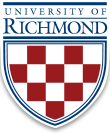The University of Richmond Museums presents Collecting Paradise in the Philippines: Selections from the Margaret B. Dunkum Shell Collection, on view from July 25, 2012, to November 15, 2013, in the Lora Robins Gallery of Design from Nature. Margaret B. and William W. Dunkum, Jr. (R’38), lived in the Philippine Islands from 1952 to 1982, a time when global interest in shell collecting grew dramatically. During their thirty years there while Mr. Dunkum was employed by the Reynolds Philippines Corporation, Mrs. Dunkum took advantage of the distinctive environment and spent part of her time collecting hundreds of shells. The diverse collection, comprising more than 1,500 specimens, is rich in Western Pacific marine shells and includes species from both the Philippines and around the world. In addition, she collected other marine animals, such as corals, seahorses, and sea urchins. This exhibition features a selection of more than fifty shells and corals from the Margaret B. Dunkum Shell Collection, which was donated in her memory by her daughters Barbara D. Long and Florence D. Gadol in 2005 to the Lora Robins Gallery of Design from Nature.
Few places on earth rival the Philippine Islands as a place to collect seashells. The 22,000 miles of tropical coastline is varied, including numerous rugged natural harbors, sandy beaches, and extensive coral reef systems. These areas create an incredible number and complexity of marine microhabitats, allowing for the development of new species. At least 5,000 species of shelled mollusks are found in the Islands, with new specimens being discovered and named every year, representing the highest diversity of mollusks in any country.
The exhibition showcases selected shells and corals that highlight the rich marine environment surrounding the 7,107 islands that comprise the archipelago, and also provides a brief context for understanding the anatomy of mollusks as well as their historical importance to the local economy. Selected shells include the Great Spotted Cowrie (Perisserosa guttata), the Glory-of-the-Sea Cone (Conus gloriamaris), and a Fluted Giant Clam (Tridacna squamosa).
Known locally as Sigay, cowries of many types have played a major role in the Philippine shell industry. The Great Spotted Cowrie is just one species of a huge family of Gastropods that are predominantly tropical in their distribution, and most are nocturnal in habit. They are often found living in shallow waters among coral and rocks. In the Philippines, shells such as these have been used as local currency, charms, talismans, and as decorations.
The beautiful Glory-of-the-Sea Cone (Conus gloriamaris) is probably the most famous shell among private collectors, due to its initial scarcity. First described in 1777, it was the most valuable and coveted shell in the world for more than two centuries. Because of its immense rarity, the British naturalist and collector Hugh Cuming (1791-1865), who had collected thousands of shells, was said to “faint with delight” when he serendipitously uncovered two juvenile specimens on Bohol in the Philippines. During the twentieth century, the mollusk was discovered in greater numbers in the Philippines and elsewhere in the Indo-Pacific, and while their value has declined to more modest levels, they remain popular with collectors today.
The Fluted Giant Clam, or Hagdan-hagdang, belongs to a family called Tridacnidae, and members of this family are found throughout the Philippines, although most species are located in the Sulu Sea. In addition to being edible, members of this family are used extensively for commercial purposes such as creating crafts from shells. However, due to in part to their popularity their numbers have declined in recent years.
Organized by the University of Richmond Museums, the exhibition was curated by Matthew Houle, Curator of Museum Collections, University Museums.
Curator’s Talk, Lora Robins Gallery of Design from Nature, University of Richmond Museums
Building a Shell Collection, Matthew Houle, Curator of Museum Collections, University Museums
Sunday, November 17, 2013, 2 to 3 p.m.
Museum Story Time for Children, Lora Robins Gallery of Design from Nature, University Museums
Reading from Giles Andreae and David Wojtowycz’s book “Commotion in the Ocean”
In conjunction with the exhibition Collecting Paradise in the Philippines: Selections from the Margaret B. Dunkum Shell Collection


